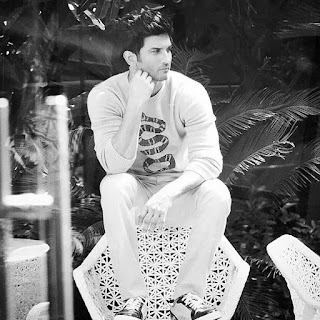RIP Sushant Singh Rajput: Let's not be voyeurs of death
Radhika Bhirani
rbhirani@gmail.com
It's the day after.
Visuals of Sushant Singh Rajput's lifeless body sprawled across an unkempt bed, fail to stop haunting. They won't. For a long time.
In an analogy that astronomy-junkie Sushant would have related to, it's like a partial eclipse; unwittingly obscuring the happy mental image of a promising and talented actor, gone too soon.
Did I need to see the sight? Who decides? News channels racing for TRPs? Nondescript social media users? Whatsapp groups? You? I? Who?
The difference between a person who just puts out or 'forwards' the 'pics' of a dead body via phone, and one who at least asks before sharing them, is one: ethics.
And just like that, "Responsible reporting is an ethical issue for an individual journalist, publication or channel. It cannot be regulated," a media and entertainment industry veteran reminds rightfully.
A senior reporter, who has had a brush with the crime beat, argues that TV news channels duly complied with the requirement of blurring the dead body, as opposed to the unscrupulous and speedy sharing of the actual images across the Internet and smartphones.
Maharashtra Cyber, nodal agency for cyber security and cybercrime investigation for Maharashtra, sprang into action, warning netizens of legal action for circulating "disturbing" pictures of the deceased actor.
As for what the TV reports, as do print publications or news agencies, the answer lies in self regulation, in responsible editorial judgment, in choosing or not choosing to put out gory details, sensational headlines, pictures, graphics and footage that could leave indelible and mostly unwanted impressions in the audience or readers' minds.
On the day Sushant Singh Rajput passed away, #ShameonAajTak and #ShameOnZeeNews were trending.
"Saason ki dor, 'Kai Po Che' ho gayi", "Aise kaise 'hit wicket' ho gaye Sushant?", "Patna ka Sushant Mumbai mein fail kyun".
These were some of the headlines which social media users condemned as "distasteful" left, right and centre. And these were apart from their judgment -- or the lack thereof -- in zooming the lens on a father grieving the sudden death of his 34-year-old son, whose personal story of 'Maruti to Maserati' was his favourite to describe his journey.
Saddened and frustrated by the lack of privacy and respect afforded to the people left behind, author Shaheen Bhatt, daughter of filmmaker Mahesh Bhatt, wrote a pertinent post on Instagram: "Funerals, chauthas and homes of grieving families are not photo ops. They can't be... Please don't participate in making the trauma worse for those already traumatised."
"Don't sensationalise grief," she asserted.
It's a statement that fuels the sentiment right when the growing voyeurism around celebrity deaths -- unforgettable as it is, the bathtub journalism when screen icon Sridevi died -- needs a serious self regulation check.
Visuals alone don't do the damage. The conversations propagate it too.
I was personally reprimanded for drawing conclusions based on hearsay, on being blinded by indiscreet blind items. "You were very prompt about claiming that Sushant was depressed based on someone else's tweet," I was told by the industry veteran.
So in retrospect, I am guilty too. Of trying to feed the curiosity around "Why did Sushant do what he did?"
Sensitivity is the need of the hour, and sensitivity in coverage is what guidelines -- both from national authorities and from the World Health Organisation -- suggest we follow. Like some responsible exceptions did.
Senior journalist Rajat Sharma, President of the National Broadcasters Association, tells me that the News Broadcasting Standards Authority has a detailed code of conduct for member-broadcasters to adhere to.
The document, Specific Guidelines Covering Reportage, in parts, reads:
* Content should not glamourize or sensationalize crime or condone criminal actions, including suicide.
* Content should not depict techniques of crime that may tempt imitation, especially with reference to terrorism and suicide.
* The dead must be treated with respect. Close-ups of dead or mutilated bodies should not be shown.
The Press Council of India also has a set of guidelines telling newspapers and news agencies what NOT to do when reporting on suicide.
* Publish stories about suicide prominently and unduly repeat such stories.
* Use language which sensationalizes or normalizes suicide, or presents it as a constructive solution to
problems.
* Explicitly describe the method used.
* Provide details about the site/location.
* Use sensational headlines.
* Use photographs, video footage or social media links.
What delves into the nitty-gritty of the whys and whats of the need for news around suicide, is a 20-page manual titled 'Preventing Suicide: A Resource for Media Professionals' from the World Health Organisation (WHO).
Touching upon language specifically, WHO suggests; the use of "die/death by suicide" or take one's own life" rather than "commit suicide" or "complete suicide" as it implies criminality, and avoiding the use of "a successful suicide attempt" or "an unsuccessful or failed suicide attempt".
Some food for thought, and action there, I hope. For all of us.
On that note, ending with an excerpt from a social media post by Sushant, "The way out is to look within".





Liked it
ReplyDeleteThanks Anuj
DeleteSo true.. !! I don't have words to say about such people, I really wish Sushant's family is allowed to grief in peace.
ReplyDeleteHope sanity prevails
ReplyDeleteI got his death pic in my mobile and felt horrified. Sushant was my fav actor and adored him. Seeing him in such pic made my heart felt cry thousand times. Rest in peace brother.
ReplyDelete